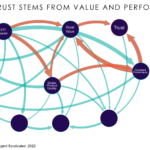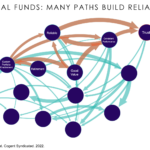
This is the last in a three-part series on building trust in the wealth management space. You can read our first blog here and the second blog here.
In business, as in life, there’s no quick and easy way to build trust. Trust is developed and strengthened over time, and the path to trust is different for each brand. That said, we can uncover patterns that help companies create their own unique strategies to foster trust with their clients. That’s where the science behind trust comes in.
Cogent Syndicated presented the results of a three-pronged analysis on trust—one of the most in-depth statistical analyses on trust in the wealth management industry.
As the foundation of this analysis, we leveraged our incredibly rich dataset of financial advisor research that contains monthly results going back to 2013. The specific datapoints we used in this analysis were our descriptive brand imagery attributes, in which we asked advisors which brands, if any, they most associate with a battery of different characteristics.
First, we established longitudinal models to identify the biggest drivers of trust over time as well as the point in time in which perceptions begin to impact trust, and are, therefore, the strongest predictors of trust.
Next, we conducted a regression analysis in which we examined the factors that drive trust. We made “a company I trust” the dependent variable, or outcome, to uncover not just the importance of trust, but how to actually build it. In this analysis, the independent variables, or “predictors” of trust, were the results of Cogent Syndicated’s descriptive brand imagery attributes.

With this understanding of the relationships on trust over time and in the moment, the question becomes how do these different perceptions of a brand work together. That’s where the third prong of our analysis, called a Bayesian network analysis, comes in. Using this technique, we can identify how the different attributes relate to each other; that is, which are direct drivers of trust and which are playing more of a supporting role, working indirectly through other variables to create a pathway to trust.
Bayesian networks are commonly used in machine learning, as they provide probabilistic models that define relationships between variables. These models capture both conditionally dependent and conditionally independent relationships between variables and can be used for inference to estimate the probabilities for causal or subsequent events or outcomes. For our purposes, we developed Bayesian networks that map the relationships between and among our brand imagery attributes to depict how they relate to each other and, ultimately, lead to trust.
Let’s start by looking at a map for the ETF market. All the arrows on the map indicate which factors are being predicted or caused by which other factors. When we remove the variables that don’t have an influence on trust—they affect other variables but not trust itself—we’re left with the same set of predictors that we saw with the first two types of analyses:
- consistent performance
- quality of global products
- good value
But what this network helps us understand is the extent to which these effects lead directly or indirectly to trust. For example, good value and consistent performance have direct relationships to trust—arrows directly link these variables together. The role of global product quality and being an ETF leader are more indirect in the path to trust. The arrows stemming from these variables link to other things first. It’s interesting to note that consistent performance is also impacting trust through perceptions of good value.
So, what can you make of a map like this? When considering product offerings, when designing messaging, when thinking about brand positioning, this visual quickly tells you to use consistency and overall value to gain trust. The secondary levers are your industry leadership (if you can make a credible claim in that category) and/or your overall product quality—particularly if it has global elements. These factors pay off multiple times. It’s really interesting to see that there’s a strong reciprocal connection between value and leadership as well as value and consistent performance. These are strong reinforcing loops you can leverage in messaging, advertising and product selection.

In the mutual fund market map, as we remove variables that don’t have an influence on trust (they relate to other variables but not to trust), we reveal the paths that reinforce the results we found longitudinally and within a given time period. Consistent performance and reliability are the most immediate drivers of trust. But we do see indirect paths to trust from good value, being known for retirement solutions and custom portfolios enablement. For mutual fund providers, it’s essential to understand the role these factors play and how they ladder together.
The key takeaway from this map is that all roads to trust lead through either consistent performance or reliability to trust. In fact, consistent performance reinforces reliability. You can also see the strong arrow leading to value that then moves to consistency and then on to trust. Yet we see some interesting new variables playing important supporting roles. As the mutual fund industry becomes more and more synonymous with retirement, that factor becomes one of the key gateways to trust. In addition, custom portfolio enablement is a different type of dimension in which firms provide the advisor with an additional set of tools in order for them to deliver the value to their end clients. All this gives you more things to talk about rather than just reliability and consistent performance.

The pathway to trust differs by firm based on the level of trust each brand has already established, but the components don’t differ that widely. That’s why we conducted these analyses at the category level. While this is a complex topic—particularly among a professional population of advisors—we believe the process builds the same way across much of the category. There might be some niche brands that build trust in different ways but the bulk of firms in the category builds trust in the same way. But it’s important to understand where you’re starting from and how your brand is being perceived. That knowledge coupled with our insight on the factors that drive trust in the market will be critical components in your growth strategy going forward.
Want to know more? Watch a replay of our latest webinar or send us a note to learn how we can help you find the right levers to pull to build, strengthen and harness trust in your brand.









